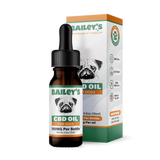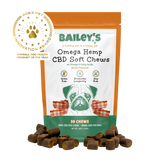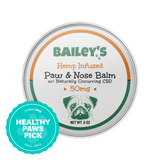Rocky Mountain Horse: Breed Characteristics

The Rocky Mountain Horse is a captivating and versatile breed that has captured the hearts of horse enthusiasts around the world. With its unique gait, stunning appearance, and gentle temperament, this breed offers a truly exceptional experience for both riders and owners.
In this article, the team at Bailey’s CBD invites you to explore the various aspects of the Rocky Mountain Horse, including its origin and history, physical characteristics, temperament, unique traits, care requirements, and its roles in different disciplines.

Table of Contents
1. Understanding the Rocky Mountain Horse
1.1 Origin and History
The Rocky Mountain Horse breed originated in the United States, specifically in the Appalachian region of Kentucky. Developed by dedicated breeders who sought a versatile and reliable mount, the breed has a rich and captivating history. Originally known as the Rocky Mountain Saddle Horse, it was bred to be a comfortable and smooth-gaited horse for mountainous terrains.
With its roots deeply embedded in the Appalachian region, the Rocky Mountain Horse carries the legacy of the hardworking people who depended on these horses for their daily tasks. From traversing rugged mountain trails to carrying heavy loads, these horses were the backbone of many communities, embodying strength, endurance, and resilience.
During the mid-20th century, an influential breeder named Sam Tuttle played a significant role in shaping the Rocky Mountain Horse breed. He dedicated his life to refining the breed, meticulously selecting horses with exceptional traits and characteristics. Tuttle's vision was to create a horse that not only excelled in its gait but also possessed a kind and gentle temperament.
As the breed gained recognition, it became a symbol of pride for the Appalachian region. The Rocky Mountain Horse represented the spirit of the people and their connection to the land. Today, it continues to captivate the hearts of horse enthusiasts worldwide, carrying the legacy of its humble origins.
1.2 Physical Appearance
The Rocky Mountain Horse is renowned for its striking beauty and grace. It typically stands between 14.2 and 16 hands high and possesses a well-muscled and compact body. Its strong legs and sturdy build allow it to navigate challenging terrains with ease, making it an ideal companion for adventurous riders.
With its refined head, expressive eyes, and small, alert ears, the Rocky Mountain Horse exudes elegance and intelligence. Each horse has a unique personality that shines through its eyes, reflecting its gentle and kind nature. The breed's distinctive facial features make it instantly recognizable and add to its overall charm.
While the Rocky Mountain Horse comes in various coat colors, the most iconic and recognized is the chocolate coat, often referred to as "chocolate flaxen." This lustrous coat, accompanied by a flaxen or light-colored mane and tail, adds to the breed's overall allure. The rich, deep tones of the chocolate coat glisten under the sunlight, creating a mesmerizing sight that captures the attention of all who behold it.
Furthermore, the Rocky Mountain Horse's mane and tail are known for their luxurious and flowing appearance. The contrasting colors of the mane and tail against the chocolate coat create a visually stunning combination that further enhances the breed's beauty.
1.3 Temperament and Personality
One of the most endearing qualities of the Rocky Mountain Horse is its gentle and willing temperament. Known for their docile and calm nature, they are often considered the "golden retrievers" of the horse world. These horses possess an innate sense of empathy and are quick to form strong bonds with their human companions.
Due to their friendly and easy-going nature, Rocky Mountain Horses are suitable for riders of all ages and skill levels. Whether it's a beginner rider taking their first steps in the equestrian world or an experienced rider seeking a reliable and trustworthy mount, the Rocky Mountain Horse never fails to impress.
Intelligence is another trait that sets the Rocky Mountain Horse apart. These horses possess a remarkable ability to understand and respond to their rider's cues, making them highly trainable and versatile. Their eagerness to please their rider, combined with their calm temperament, allows them to excel in various activities, including trail riding, pleasure riding, and even working roles.
Moreover, the Rocky Mountain Horse's gentle disposition extends beyond its interactions with humans. These horses are known for their ability to get along well with other animals, making them excellent companions on the trail or in the pasture. Their friendly and sociable nature ensures a harmonious environment wherever they go.

2. Unique Traits of the Rocky Mountain Horse
The Rocky Mountain Horse is a remarkable breed known for its distinctive characteristics and exceptional qualities. From its smooth and comfortable ambling gait to its stunning color variations, this breed has captivated horse enthusiasts around the world.
2.1 Gait and Movement
One of the most remarkable features of the Rocky Mountain Horse is its unique gait, known as the "single-foot." This four-beat gait sets the breed apart from others, providing riders with an incredibly smooth and comfortable riding experience. Unlike the jarring trot or bumpy canter of other breeds, the Rocky Mountain Horse's gait allows riders to effortlessly glide through the terrain, making it an ideal choice for long hours in the saddle and rough terrains.
With each step, the horse's hooves hit the ground in a precise and rhythmic manner, creating a harmonious motion that is both relaxing and enjoyable. This exceptional gait not only enhances the rider's comfort but also showcases the breed's natural athleticism and grace.
2.2 Color and Markings
While the iconic chocolate coat color is synonymous with the Rocky Mountain Horse, this breed also exhibits a stunning array of other colors. From sleek blacks to rich bays, shimmering palominos to elegant grays, each horse's coat tells a unique story.
In addition to their captivating coat colors, many Rocky Mountain Horses boast distinctive markings that further enhance their beauty. Some horses may have white socks, which are patches of white on their lower legs, while others may have blazes, which are white markings on their faces. A few lucky individuals even possess a flaxen mane and tail, adding an extra touch of elegance to their appearance.
These various colors and markings not only make each Rocky Mountain Horse visually striking but also reflect the breed's genetic diversity and versatility.
2.3 Lifespan and Health
The Rocky Mountain Horse is renowned for its robustness and longevity. With proper care and management, these horses can live well into their twenties or even thirties, providing their owners with many years of companionship and enjoyment.
To ensure the breed's overall health and well-being, regular veterinary care, a balanced diet, and appropriate exercise are crucial. By providing these essential elements, owners can help their Rocky Mountain Horses thrive and maintain their vitality throughout their lives.
While the breed is generally hardy, like any horse, the Rocky Mountain Horse can be prone to certain health issues. Lameness and metabolic disorders are among the conditions that may affect these horses. However, responsible breeding practices and attentive care can significantly minimize these risks, safeguarding the breed's long-term health and preserving its exceptional qualities.
By understanding and appreciating the unique traits of the Rocky Mountain Horse, we can truly grasp the magnificence of this remarkable breed. From their smooth and comfortable gait to their captivating colors and markings, these horses continue to captivate the hearts of equestrians worldwide.
3. Caring for a Rocky Mountain Horse
The Rocky Mountain Horse is a beautiful and versatile breed that requires proper care and attention to thrive. In addition to providing a balanced diet, regular exercise, and grooming, there are several other aspects to consider when caring for these magnificent creatures.
3.1 Dietary Needs
The Rocky Mountain Horse has relatively modest dietary requirements. A diet consisting of high-quality forage, such as grass or hay, supplemented with a balanced concentrate feed, is generally sufficient to meet their nutritional needs. Any other quality vitamins or supplements can be administered at the direction of your horse’s favorite veterinarian. It is essential to provide clean and fresh water at all times and monitor their weight and body condition to prevent obesity or malnutrition.
When it comes to their diet, it's important to remember that horses are herbivores and have a unique digestive system. They rely on a steady intake of fiber to keep their digestive tract healthy and functioning properly. Providing access to pasture or high-quality hay is crucial to meet their forage needs.
Supplementing their diet with a balanced concentrate feed can help ensure they receive the necessary vitamins, minerals, and proteins. However, it's important to consult with a veterinarian or equine nutritionist to determine the appropriate amount and type of concentrate feed for your Rocky Mountain Horse.
3.2 Exercise and Training
The Rocky Mountain Horse is a naturally athletic breed that requires regular exercise to maintain physical and mental well-being. Regular turnout in a safe and spacious paddock or pasture is important to allow them to stretch their legs and engage in natural behaviors.
These horses enjoy being active and benefit from various forms of exercise. Incorporating regular training sessions into their routine can help establish a strong bond between horse and rider. The breed's intelligent and willing nature makes them quick learners, and they excel in various disciplines, including dressage, trail riding, and even jumping.
When it comes to training, it's important to use positive reinforcement techniques and be patient and consistent. Building a solid foundation of trust and respect will create a harmonious partnership between you and your Rocky Mountain Horse.
3.3 Grooming and Maintenance
Grooming is an essential aspect of caring for a Rocky Mountain Horse. It not only helps maintain their coat's shine and cleanliness but also offers an opportunity to bond with the horse and monitor their overall health.
A regular grooming routine should include brushing the coat to remove dirt and debris, picking out hooves, and inspecting for any signs of injury or abnormalities. Additional grooming tasks, such as mane and tail care, should be performed as needed, ensuring the horse's overall grooming needs are met.
During grooming sessions, take the time to check their teeth, eyes, and ears for any potential issues. Regular dental care, including floating their teeth, may be necessary to ensure proper chewing and digestion.
Furthermore, it's important to pay attention to their hooves. Regular farrier visits are essential to maintain proper hoof health and prevent any discomfort or lameness.
By providing regular grooming and maintenance, you not only keep your Rocky Mountain Horse looking their best but also contribute to their overall well-being and happiness.

4. The Rocky Mountain Horse in Various Disciplines
4.1 Show Ring Achievements
The Rocky Mountain Horse has gained recognition in the show ring for its versatility and beauty. Its stunning appearance, coupled with its smooth gait and gentle temperament, makes it a contender in various show classes. The breed has excelled in events such as gaited classes, dressage, western pleasure, and even driving competitions.
4.2 Trail and Pleasure Riding
Due to their comfortable gait and calm temperament, Rocky Mountain Horses are highly sought after for trail riding and pleasure riding activities. Whether exploring rugged mountain trails or leisurely navigating scenic country paths, these horses offer riders a relaxing and enjoyable experience.
4.3 Work and Utility Roles
Despite being primarily known for its recreational abilities, the Rocky Mountain Horse can also be utilized in various work and utility roles. Their strength, agility, and cooperative nature make them well-suited for tasks such as ranch work, herding livestock, and even light farm work.
5. Conclusion
In conclusion, the Rocky Mountain Horse breed encompasses a unique combination of beauty, versatility, and exceptional temperament. Its origin and history, physical appearance, temperament, unique traits, care requirements, and roles in different disciplines make it a remarkable horse in the equestrian world. Whether you are a trail rider, a competitor in the show ring, or simply seeking a trustworthy equine partner, the Rocky Mountain Horse is sure to leave a lasting impression.











